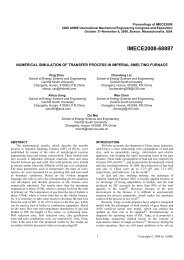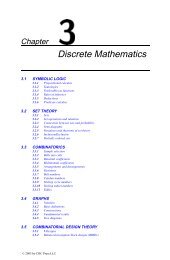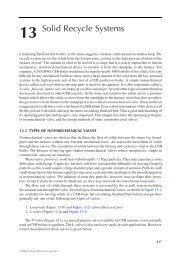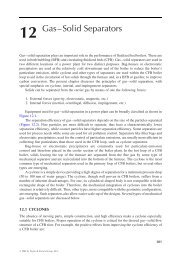Chapter 4: Geometry
Chapter 4: Geometry
Chapter 4: Geometry
You also want an ePaper? Increase the reach of your titles
YUMPU automatically turns print PDFs into web optimized ePapers that Google loves.
4.10.3 PROJECTIVE TRANSFORMATIONS<br />
A transformation that maps lines to lines (but does not necessarily preserve parallelism)<br />
is a projective transformation. Any spatial projective transformation can be<br />
expressed by an invertible ¢ matrix in homogeneous coordinates; conversely, any<br />
invertible ¢ matrix defines a projective transformation of space. Projective transformations<br />
(if not affine) are not defined on all of space, but only on the complement<br />
of a plane (the missing plane is “mapped to infinity”).<br />
The following particular case is often useful, especially in computer graphics,<br />
in projecting a scene from space to the plane. Suppose an observer is at the point<br />
´Ü ¼ Ý ¼ Þ ¼ µ of space, looking toward the origin Ç ´¼ ¼ ¼µ. Let È , the<br />
screen, be the plane through Ç and perpendicular to the ray Ç. Place a rectangular<br />
coordinate system on È with origin at Ç so that the positive -axis lies in the halfplane<br />
determined by and the positive Þ-axis of space (that is, the Þ-axis is pointing<br />
“up” as seen from ). Then consider the transformation that associates with a point<br />
´Ü Ý Þµ the triple ´µ, where ´µ are the coordinates of the point, where<br />
the line intersects È (the screen coordinates of as seen from ), and is the<br />
inverse of the signed distance from to along the line Ç (this distance is the<br />
depth of as seen from ). This is a projective transformation, given by the matrix<br />
¾<br />
<br />
<br />
Ö ¾ Ý ¼ Ö ¾ Ü ¼ ¼ ¼<br />
ÖÜ ¼ Þ ¼ ÖÝ ¼ Þ ¼ Ö ¾ ¼<br />
¼ ¼ ¼ Ö<br />
with <br />
Ô<br />
Ü<br />
¾<br />
¼ · ݾ ¼ and Ö Ô<br />
Ü<br />
¾<br />
¼ · ݾ ¼ · Þ¾ ¼ .<br />
(4.10.5)<br />
Ü ¼ Ý ¼ Þ ¼ Ö ¾ <br />
¿<br />
<br />
4.11 DIRECTION ANGLES AND DIRECTION<br />
COSINES<br />
Given a vector ´ µ in three-dimensional space, the direction cosines of this vector<br />
are<br />
<br />
Ó× « Ô<br />
¾ · ¾ · <br />
¾<br />
<br />
Ó× ¬ Ô<br />
¾ · ¾ · <br />
¾ (4.11.1)<br />
<br />
Ó× Ô<br />
¾ · ¾ · ¾<br />
Here the direction angles «, ¬, are the angles that the vector makes with the positive<br />
Ü-, Ý- and Þ-axes, respectively. In formulae, usually the direction cosines appear,<br />
rather than the direction angles. We have<br />
Ó× ¾ « ·Ó× ¾ ¬ · Ó× ¾ ½ (4.11.2)<br />
© 2003 by CRC Press LLC










